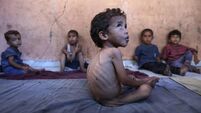Michael Clifford: Is inequality improving or worsening in Ireland?

International studies say Ireland's income gap is narrowing, but inequality remains rife in the country. Stock Picture.
International surveys say Ireland's income gap is narrowing and that the country is one of the best places in the world to live — but does this reflect the reality, asks
YOU'VE NEVER had it so good.
So goes one narrative about alleged rising standards of living in the Republic of Ireland. A series of studies and surveys, both national and international, have painted the country in bright colours.
The latest of these was published with little fanfare on December 23. The United Nations Human Development Index (HDI) puts Ireland as the second best place on the planet to live, behind Norway and ahead of Switzerland. The UK, our nearest neighbour, doesn’t feature in the top ten.
Last November, UCC economist and former chair of the Fiscal Advisory Council, Seamus Coffey, pointed to data which demonstrates that Ireland has been an outlier in terms of equality over the last 30 years.
While in every other developed country the gap between rich and poor has widened, it has narrowed in Ireland, at a time when incomes rose. That of itself is a unique achievement.

In November also, the Central Statistics Office (CSO) published its annual Survey of Income and Living Conditions (SILC) for 2019.
That illustrated how between 2014 and 2019 the average income of the bottom tenth of the population increased by 70%, going from €130 to €213. By contrast, the top 10% of the population saw an increase of just over 20%.
Nobody is suggesting that living on €213 is easy, but the difference — in percentage terms — between those at the bottom and the top is seen by some as evidence of closing the income gap.
All of this is played out against growing inequality in most developed countries, which in turn has prompted political upheaval.
In this country, those who are described as being on the left of the political spectrum are constantly citing growing inequality, not least in pitting what they class the “elite” against the vast majority of “ordinary people”.
This perception received ballast in the general election last year with the emergence of Sinn Féin as a major political force.
In a recent podcast by UCD’s New Political Economy, political scientist Kevin Cunningham pointed to data which showed that income inequality was a major factor in the election.
“This income stuff is bigger (than other issues in the election),” Cunningham said. “You can look at any graph and see a difference between the parties and the big Kahuna here is income. That tells me a story that isn’t being covered by economists.”
So are the statistics, both homegrown and from international organisations, lying? Is inequality rising or falling?
Kathleen Lynch is emeritus professor of Equality Studies in UCD.
“They say that inequality is falling, but falling by what and from where,” she says. “The problems with a lot of these studies is they deal with averages or aggregates.
“They don’t do it by groups like, for instance, lone parents or travellers or Black people or carers. There is absolutely no evidence that any of those groups are experiencing less poverty.”
The hidden aspects to the overall picture are also cited by Ciaran Nugent of the Nevin Economic Research Institute (NERI) think tank.
“There is an intergenerational divide,” he says. “The HDI or the SILC do not reflect the generational inequities, particularly in relation to rent and wages.”
He says that if anything inequality has risen, particularly since the economic crash in 2008.
“We can talk about household indicators, but when you get into whether or not you can afford a second pair of shoes or a night out or if you have an unexpected cost like a car breakdown or a boiler going, the indicators show that insecurity about living standards and income is higher than in 2007.”
Nugent also points out that the surveys in question measure income and not wealth, which, he says, would give a more accurate picture of inequality.
Seamus Coffey says most of these issues are taken account of in the various studies.
“The CSO has done surveys on wealth, a household finance and consumption survey, it’s done every five years.
“For instance between 2013 and 2018, wealth inequality fell, and that was mainly down to house prices.”
He accepts that there are sub-groups who may not be benefiting from rising incomes, but he doesn’t believe that that affects falling inequality overall.
Read More
“In terms of the housing situation, two-thirds of people are owner-occupiers,” he says. “Between 15% and 18% are social housing tenants."
Market rents don’t have an impact on those.
“There is a group out there facing higher rents but that’s not showing up (in the studies) because, in overall terms, they are not that large even though the impact on the people themselves is of course large.”
He also says that while precarious working is an issue, there is no evidence that it is a growing problem.
“There is inequality there, nobody is denying that. But it’s not growing. Up until recent years you would have said it was flat but since 2016 it leans more towards falling."
However one plays the numbers, there are a few stark figures that would, certainly on the face of it, question the contention that this is the second best country in the world in which to live.
The SILC survey did show falling inequality but it also highlighted that 637,000 people continue to live in poverty in a country with less than a population of 5m; among this cohort are 193,600 children under the age of 18.
Included in those who are officially in poverty are 98,100 who are in employment. And those at risk of poverty and experiencing deprivation in general is 886,000, of which 293,200 are children.
These figures point to a major child poverty problem, whatever the figures say about rising incomes and falling inequality.
Fr Sean Healy, director of Social Justice Ireland says that the lived experience of that large cohort of people disputes any basis for congratulations, as per the international studies.

“This thing about falling inequality is a big spin,” he says. “In the first instance, the UN’s Human Development Index is compiled on a very narrow basis.”
He suggests that the Survey on Income and Living Conditions is an illusion in respect of inequality.
“If you look at the lived experience in Ireland there is no doubt that we have a housing and homeless problem,” he said.
"And when you look at how they calculate the deprivation index. These measures are agreed between European governments. Again that does not mean that they reflect lived experience," he added.
“Whenever it comes to a conflict between statistics and lived experience, it is the latter that I will always go with.”
Sean Healy also points to one element of the SILC that, he says, demonstrates an aspect of the domestic economy that can contribute to skewing the overall impression.
Before social transfers are included, Ireland has one of the highest levels of inequality in terms of its market economy. Transfers, which include pensions, child benefit, supplementary income and a range of other payments, bring that level of inequality down to the EU average.
Fr Healy makes the point that the stats show that without state transfers 41% of people would be living in poverty instead of the actual 12.8%.
“What that shows is that the key to keeping poverty rates down is welfare payments of one sort or another,” he says.
“So how do you justify two budgets in a row not increasing welfare rates if there is supposed to be falling inequality? That’s why it is so important in this economy that focus is kept on welfare rates.”
He does not accept the argument that as Ireland is considered to be mid-table in European terms, then we’re doing alright in aiming for equality.
“It’s rubbish,” he says. “Because to approach it that way is to say that you’re trying to achieve Utopia if you want to reduce poverty rates below 12.5%.
Again, Seamus Coffey begs to differ.
“There are lots of different views on what the figures mean,” he says. “And there is no one best solution but I do not think the evidence is as clear-cut as the popular narrative would have it," said Mr Coffey.
“There is no doubt that we have inequality but it has fallen over the last 10 years. In a lot of countries inequality is getting worse but in Ireland this has not been the case.
"Some who look at it from a progressive point of view say we are not doing enough but look for instance at our tax and transfer system. That appears to be successful yet some just want to focus on the failures.”











